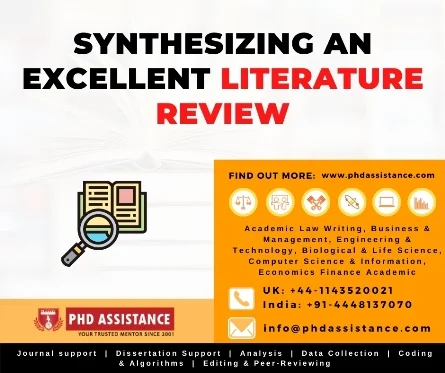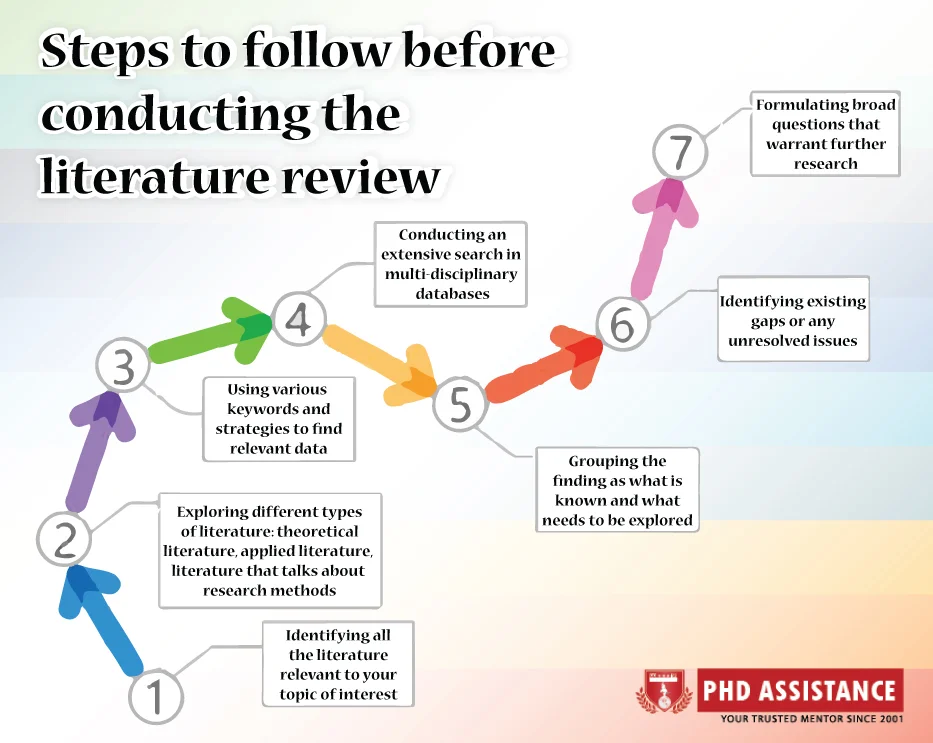SYNTHESIZING AN EXCELLENT LITERATURE REVIEW
Introduction
A literature review survey the books, scholarly papers, and any other sources related to a specific issue, field of study, or theory, and provides a description, summary, and critical evaluation of these works in connection to the research subject under consideration. Literature reviews are aimed to offer readers an overview of the sources you used when researching a certain issue and to show them how your research fits into a larger field of study. A summary is a re-organization, or reshuffling, of that material in a way that informs how you plan to examine a research topic, whereas a synthesis is a re-organization, or reshuffling, of that information in a way that informs how you plan to explore a research problem.

Literature review
Literature Review presents information in a manner that leads to building a new framework. It provides a context to your research work and pins down to your research problem. Other essential aspects of a literature review are as follows:
- It highlights the principal issues in your field.
- It provides new perspectives on the research topic.
- It introduces relevant terminologies used in the context of your work.
- It assists in recognizing related research findings and relevant theories.
- It aids in locating the methods that one may take on for research.

Steps to follow before conducting the literature review:
- Identifying all the literature relevant to your topic of interest
- Exploring different types of literature: theoretical literature, applied literature, literature that talks about research methods
- Using various keywords and strategies to find relevant data
- Conducting an extensive search in multi-disciplinary databases
- Grouping the findings as what is known and what needs to be explored
- Identifying existing gaps or any unresolved issues
- Formulating broad questions that warrant further research
To analyze a research paper, look for adequate information for the following questions in it:
- Is the research question appropriate to the problem/issue?
- Does the research question define the scope and relevance of the study?
- Could the research question be approached through an alternative perspective?
- Has the research problem been critically analyzed, or has it been just interpreted?
- Has the literature considered both the latest and relevant articles?
- How have the basic components such as the population, interventions, outcomes of the study been defined?
- Are the measurements effective, accurate and statistically significant?
- Are the conclusions based on correct interpretations of the data?
- Is the reasoning provided for the problem statement objective- based and unbiased?
- Are there any preconceived beliefs and opinions presented in the reasoning?
- How would the selected materials add to your knowledge of the research problem?
- What are the strong points, restrictions and inadequacies of the study?
How to write a Comprehensive Literature Review
- Have clearly defined research aims before you start with your review. Focused questions help direct your search. They assist in creating a list of keywords related to your research problem. Also, they help in identifying relevant databases in journals and articles.
- Check if you have correctly identified all the sources that could answer your research question. In addition to journal articles, theses, and dissertations, refer internet sources, conference reports that offer the latest papers not available in publications, and reports presented by the government and the corporate bodies. Even books can prove useful for background information.
- Consider both qualitative and quantitative research An exhaustive literature survey helps to create a case as to why further study is necessary.
- Have adequate experimental evidence to support your hypothesis and to justify the significance of your study.
- Identify all the major shortcomings related to your research topic. By referring to articles that provide either inconclusive or contradictory information, you can identify any open questions missed by researchers in previous studies.
- Have a relationship diagram as it would recognize links between different components of your research topic. It helps gain insights into all the potential relationships between key concepts, variables and key factors.
- Use reliable procedural and investigative techniques. Gather sufficient evidence from the literature about the accuracy and validity of the methods you plan to use in your experiments.
- Identify the purpose served by each article that has been shortlisted for literature review.
- Develop a theoretical base for your study.
- Demonstrate inconsistencies, limitations, or shortcomings of previous studies.
- Evaluate certain findings.
- Repeat the study in an altered setting. Show how this study supports or contradicts your findings, and use it as a reference to build your research. Demonstrate a general understanding of apprehensions relevant to your research topic
Conclusion
In conclusion, a literature review must be structured, logical, and coherent. Have appropriate sections for different themes. Let your Literature Review prove your expertise as a researcher.
References
- Garrard, J. (2020). Health sciences literature review made easy.
- Paul, J., & Criado, A. R. (2020). The art of writing literature review: What do we know and what do we need to know?. International Business Review, 29(4), 101717.
- Karjo, C. H. A SYSTEMATIC LITERATURE REVIEW OF ENGLISH LANGUAGE TEACHING JOURNAL.
- Li, J., Krishnamurthy, S., Roders, A. P., & van Wesemael, P. (2020). Community participation in cultural heritage management: A systematic literature review comparing Chinese and international practices. Cities, 96, 102476.
- Iriarte, C., & Bayona, S. (2020). IT projects success factors: a literature review. SciKA-Association for Promotion and Dissemination of Scientific Knowledge.
- Dicle, O., Özan, S., Şahin, H., & Seçil, M. (2021). How to perform an excellent radiology board examination: a web-based checklist. Insights into Imaging, 12(1), 1-11.
- Eicher, S. (2021). What the literature tells us about bootlegging in R&D–a systematic literature review. Uncovering Covert Innovation, 11-42.
- Calegari, R., Ciatto, G., Mascardi, V., & Omicini, A. (2021). Logic-based technologies for multi-agent systems: a systematic literature review. Autonomous Agents and Multi-Agent Systems, 35(1), 1-67.
 Previous Post
Previous Post Next Post
Next Post
